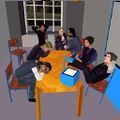'Session 7 - Clinical Use of VR'
Contents
Experimental Use
Virtual Reality (in virtuo) experiments can be used to increase the ecological/external validity of experimental setups. It allows a better 'bench-to-bedside' translation of the findings.
Pro:
- completely controlled sensory input (minimal set of stimuli can be modelled to elicit a specific behavioral/neural pattern)
- neural patterns associated with action or sensory input can be disentangled
- easily measurable neural activity due to physically constrained subject
Con:
- only a subset of the sensory input can be simulated (vestibular acceleration, head movement, smell etc.. are neglected): reduced generalizability and systematic overestimation of influence of visual input
Therapeutical Use
Psychiatry: Exposure Therapy
VR shows promising results in exposure therapy to treat anxiety disorders. The effectiveness of in virtuo exposure is similar or even higher than the effectiveness of in vivo exposure to social stimuli in patients with social anxiety. This could be, because the patients are able to perform in an completely risk-free and fully controlled environment in VR-therapy.
Neurology: Phantom Limb Pain
It could be shown that, in patients suffering from phantom limb pain, for whom conventional methods failed to improve the pain, an augmented reality therapy was effective. The missing limb was simulated on a screen, visible to the patient, and EMG signals were mapped to corresponding movements.
Neurology: Movement Therapy
VR and interactive video gaming may be beneficial for motor rehabilitation of stroke patients. An improvement could be shown for motor function of the upper limbs as well as a general improvement for the patients for their activities of the daily living.
Other Applications
Many other ways to use VR in an clinical environment are possible. E.g. surgery training, patient entertainment ect...


